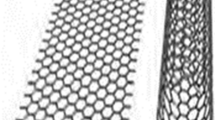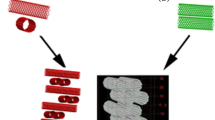Abstract
By inserting a carbon chain, the geometric structure and electronic properties of carbon nanotube (CNT) would undergo a significant change. Numerous studies have conducted to experimentally find the insertion effect of carbon chains on CNTs. This paper in a theoretical way studied the geometry of carbon chains inserted CNTs and analyzed the mechanism for conductivity change after insertion of carbon chains. Results indicate that carbon chains in the innermost channel of the tube are effective methods for transforming the electrical properties of the CNT, leading to the redistribution of electron and thereby causing the conductivity change in obtained configurations.




Similar content being viewed by others
References
Y.B. Yan, J.W. Miao, Z.H. Yang, F.X. Xiao, H.B. Yang, B. Liu, and Y. H. Yang: Carbon nanotube catalysts: recent advances in synthesis, characterization and applications. Chem. Soc. Rev. 44, 3295 (2015).
X. Fan, L. Liu, J. Lin, Z. Shen, and J.L. Kuo: Density functional theory study of finite carbon chains. ACS Nano 11, 3788 (2009).
N.F. Andrade, T.L. Vasconcelos, C.P. Gouvea, B.S. Archanjo, C.A. Achete, Y.A. Kim, M. Endo, C. Fantini, M.S. Dresselhaus, and A.G. Souza Filho: Linear carbon chains encapsulated in multiwall carbon nanotubes: resonance Raman spectroscopy and transmission electron microscopy studies. Carbon 90, 172 (2015).
X. Zhao, Y. Ando, Y. Liu, M. Jinno, and T. Suzuki: Carbon nanowire made of a long linear carbon chain inserted inside a multiwalled carbon nanotube. Phys. Rev. Lett. 18, 187401 (2003).
V. Scuderi, S. Scalese, S. Bagiante, G. Compagnini, L. D’Urso, and V. Privitera: Direct observation of the formation of linear C chain/carbon nanotube hybrid systems. Carbon 47, 2134 (2009).
L. Shi, P. Rohringer, K. Suenaga, Y. Niimi, J. Kotakoski, J.C. Meyer, H. Peterlik, M. Wanko, S. Cahangirov, and A. Rubio: Confined linear carbon chains as a route to bulk carbyne. Nat. Mater. 15, 634 (2016).
L.M. Sheng, A.J. Jin, L.M. Yu, K. An, Y. Ando, and X.L. Zhao: A simple and universal method for fabricating linear carbon chains in multiwalled carbon nanotubes. Mater. Lett. 81, 222 (2012).
X.X. Zhang, H. Cui, J. Zhang, and J. Tang: Adsorption characteristic of Pd-4 cluster carbon nanotube towards transformer oil dissolved components: a simulation. Appl. Surf. Sci. 419, 802 (2017).
M.H. Dahan and M.C. Toroker: Water oxidation catalysis with Fe2O3 constrained at the nanoscale. J. Phys. Chem. C 121, 6120 (2017).
Z.K. Horastani, S. Javad Hashemifar, S. Masoud Sayedi, and M. Hossein Sheikhi: First-principles study of H2 adsorption on the pristine and oxidized (8,0) carbon nanotube. Int. J. Hydrog. Energy 38, 13680 (2013).
X.X. Zhang, Z.Q. Dai, L. Wei, and X. Wu: Theoretical calculation of the gas-sensing properties of Pt-decorated carbon nanotubes. Sensors 13, 15159 (2013).
M. Bastos and I. Camps: First-principles calculations of nickel, cadmium, and lead adsorption on a single-walled (10,0) carbon nanotube. J. Mol. Model. 20, 2094 (2014).
X.X. Zhang, H. Cui, X.C. Dong, D.C. Chen, and J. Tang: Adsorption performance of Rh decorated SWCNT upon SF6 decomposed components based on DFT method. Appl. Surf. Sci. 420, 825 (2017).
R.X. Wang, D.J. Zhang, Y.M. Zhang, and C.B. Liu: Boron-doped carbon nanotubes serving as a novel chemical sensor for formaldehyde. J. Phys. Chem. B 110, 18267 (2006).
X.X. Zhang, Z.Q. Dai, Q.C. Chen, and J. Tang: A DFT study of SO2 and H2S gas adsorption on Au-doped single-walled carbon nanotubes. Phys. Scr. 89, 065803 (2014).
M. Penza, R. Rossi, M. Alvisi, G. Cassano, M.A. Signore, E. Serra, and R. Giorgi: Pt- and Pd-nanoclusters functionalized carbon nanotubes networked films for sub-ppm gas sensors. Sens. Actuators B, Chem. 135, 289 (2008).
A.S. Rad: Al-doped graphene as a new nanostructure adsorbent for some halomethane compounds: DFT calculations. Surf. Sci. 645, 6 (2016).
K.H. Istadeh, R. Kalantarinejad, M.J. Aghaei, and M.R. Soleymani Yazdi: Computational investigation on H2S adsorption on the CNT channel of conductometric gas sensor. J. Comput. Theor. Nanosci. 10, 2708 (2013).
Y. Li, M. Hodak, W.C. Lu, and J. Bernholc: Mechanisms of NH3 and NO2 detection in carbon-nanotube-based sensors: an ab initio investigation. Carbon 101, 177 (2016).
M. Penza, R. Rossi, M. Alvisi, D. Suriano, and E. Serra: Pt-modified carbon nanotube networked layers for enhanced gas microsensors. Thin Solid Films 520, 959 (2011).
K. Li, W. Wang, and D. Cao: Metal (Pd, Pt)-decorated carbon nanotubes for CO and NO sensing. Sens. Actuators B, Chem. 159, 171 (2011).
A.S. Rad, and E. Abedini: Chemisorption of NO on Pt-decorated graphene as modified nanostructure media: a first principles study. Appl. Surf. Sci. 360, 1041 (2016).
R. Moradi, S.A. Sebt, H. Karimi-Maleh, R. Sadeghi, F. Karimi, A. Bahari, and H. Arabi: Synthesis and application of FePt/CNTs nanocomposite as a sensor and novel amide ligand as a mediator for simultaneous determination of glutathione, nicotinamide adenine dinucleotide and tryptophan. Phys. Chem. Chem. Phys. 15, 5888 (2013).
Acknowledgment
This study was supported by the Natural Science Foundation of China (grant no. 51674055).
Author information
Authors and Affiliations
Corresponding author
Contributions and competing interests
Contributions and competing interests
H. C. performed this work and wrote this manuscript, G. Q. guided this work, while Q. L. and J. W. modified writing in order to improve its quality. All authors have no interest conflict about its submission.
Rights and permissions
About this article
Cite this article
Cui, H., Li, Q., Qiu, G. et al. Carbon-chain inserting effect on electronic behavior of single-walled carbon nanotubes: a density functional theory study. MRS Communications 8, 189–193 (2018). https://doi.org/10.1557/mrc.2018.20
Received:
Accepted:
Published:
Issue Date:
DOI: https://doi.org/10.1557/mrc.2018.20




